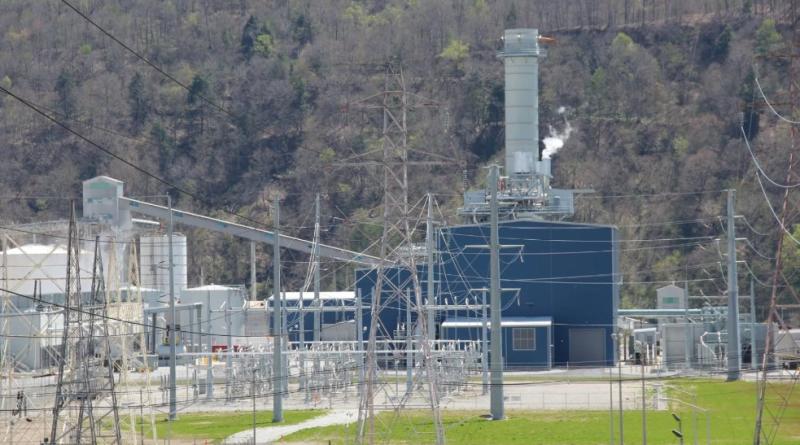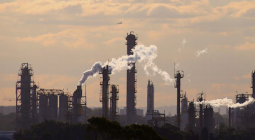Groups say 'clean' hydrogen projects lack transparency and fear climate, safety impacts

Hydrogen is considered a potential source of clean energy as the world steers away from burning fossil fuels, the main cause of global warming.
But a growing number of organizations in Western Pennsylvania say they’re worried about proposals for a so-called ‘hydrogen hub’ in the region — where a network of companies would produce, process and use hydrogen. They say the public has been kept in the dark about the projects, and are worried about what impacts they’ll have on local communities.
Two proposed hubs based in Western Pennsylvania — the Appalachian Regional Clean Hydrogen Hub, or ARCH2, and the Decarbonization Network of Appalachia, or DNA — are among over 20 vying for federal hydrogen funding.
The Appalachian hubs would produce “blue” hydrogen — where the element is stripped out of natural gas, and carbon dioxide produced in the process gets injected underground, instead of being released into the atmosphere.
Others have proposed using renewables to create hydrogen out of water, known as “green” hydrogen, or the same process using nuclear energy, known as “pink” hydrogen.
President Biden’s Bipartisan Infrastructure Law included $7 billion to fund six to 10 hydrogen hubs around the country. The law mandated that two of the hubs be located in a region with large natural gas resources.
Lack of transparency
But what is involved in building the projects, where will they be sited, how many jobs will go to local populations, what will be the environmental impacts — all of that is being kept secret by the Department of Energy, which is reviewing the applications.
“The applicants have completely cut out the public and impacted community members…from any decisions regarding their operations and plans and infrastructure footprints, and policymakers have done little to hold them accountable for that,” said Tom Torres, hydrogen campaign coordinator for the Ohio River Valley Institute. “Unfortunately, even at this point, there’s very little information about either of the specific hubs and, you know, what their impacts could be.”
The ARCH2 consortium required community groups to sign a non-disclosure agreement to see details of the proposal, according to a report in Inside Climate News.
In a statement, the Department of Energy said clean hydrogen would play a critical role in President Biden’s “vision of a clean energy future.” The agency said it has put in place mandates that the hubs applying for federal funds include a community benefits plan describing how the groups will interact with community and labor groups, and meet the administration’s workforce, diversity and environmental justice goals.
It also said it will “support successful applicants and host communities in ongoing community engagement, including as reflected in the Community Benefits Plans throughout the full project scope.”
ARCH2 did not respond to requests for comment. A spokesperson for the other applicant, the Decarbonization Network of Appalachia, did not comment by press time.
Fracking risks and skepticism about climate claims
While few details are known about the proposals, they’ve attracted big oil and gas companies like Shell and EQT. Torres worries about what continued extraction could mean for the region.
“The method of hydrogen production involves a significant amount of fossil fuels and so they’ll be using hydrogen from fracking, which comes with a lot of associated risks to public health and to the environment,” Torres said.
A recent state-funded study found links between fracking and asthma and childhood lymphoma in Western Pennsylvania. Other studies have shown links to childhood leukemia, low birth weight and premature death in the elderly, among other health effects.
Environmentalists are also skeptical about blue hydrogen’s climate benefits because they say companies haven’t yet shown they can capture CO2 from hydrogen production at sufficient rates.
“We don’t think that these claims by industry that they’ll be able to capture 95% or more of the carbon dioxide from a hydrogen production facility are realistic,” said David Schlissel, director of Resource Planning Analysis at the Institute for Energy Economics and Financial Analysis.
“Studying the technology is a good idea, and doing some larger-size tests where they capture more of the CO2 over time is a good idea,” he said. “But running off and implementing it and giving tens of billions of dollars to project developers is asking for trouble.”
And there are concerns that these mega-projects, which will cost tens of billions of dollars, simply won’t make financial sense and will fail to fulfill their economic promise.
“It could become the next act in that ongoing distraction of local policy and local and state policymakers from doing work that actually can have positive impact in terms of jobs and incomes,” said Sean O’Leary with the Ohio River Valley Institute.
The institute is a policy think tank that advocates for the region to shift away from fossil fuels as a basis for the economy.
O’Leary has produced reports analyzing jobs, income and population data to argue that the natural gas industry has failed to live up to its economic promises in the region. (The group is funded by The Heinz Endowments, which also funds The Allegheny Front)
O’Leary thinks that in some industries like steel and cement, hydrogen may be the only good strategy to address climate change.
But he wants to see more green hydrogen, which is made using renewable energy.
Concerns for a CO2 pipeline build-out
Pipelines to carry and dispose of carbon dioxide are another concern. At high enough concentrations, CO2 can be deadly. A 2020 CO2 pipeline breach in Satartia, Mississippi, hospitalized dozens of people, some of whom still report having headaches and lung problems.
“It’s terrifying,” said LaTricea Adams, founder of Black Millenials 4 Flint, and a member of the White House Environmental Justice Advisory Council. Adams said many people in the community didn’t even know there was a CO2 pipeline there. “In Satartia, they had no idea what was going on. In many instances, they didn’t even know what a CO2 pipeline was and how detrimental that could be.”
The Department of Energy says it will select which projects to advance to the next stage of funding this fall.
PHOTO: Long Ridge Energy Generation, in Hannibal, Ohio started burning hydrogen along with natural gas in this photo from April, 2022, sending electricity onto the mid-Atlantic grid.





